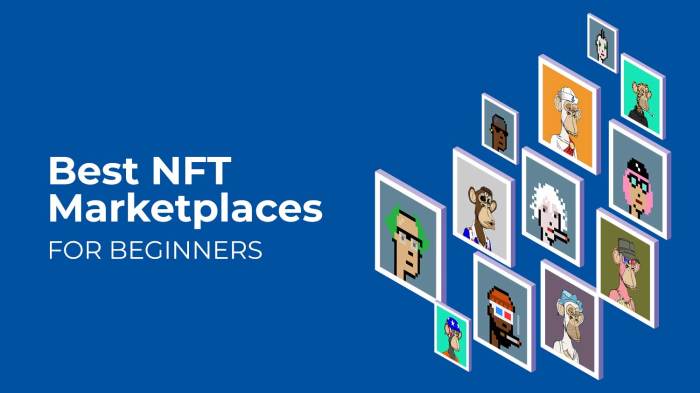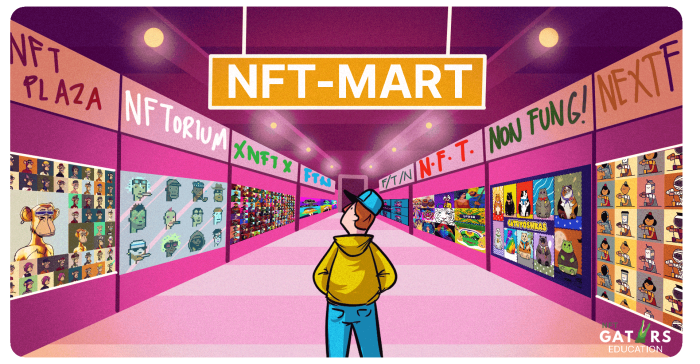NFT marketplaces, where digital art meets blockchain technology in a virtual showdown. From buying to selling, let’s explore this new frontier of online transactions with a cool high school vibe.
Exploring the ins and outs of NFT marketplaces, understanding their functions, and unraveling the mysteries behind digital ownership in the digital age.
Overview of NFT Marketplaces

NFT marketplaces are online platforms where users can buy, sell, and trade non-fungible tokens (NFTs). These marketplaces operate on blockchain technology, which ensures the authenticity and ownership of digital assets. NFTs are unique digital tokens that represent ownership of a specific item or piece of content, such as artwork, music, videos, or collectibles. Unlike cryptocurrencies like Bitcoin or Ethereum, each NFT has a distinct value and cannot be exchanged on a one-to-one basis.
Popular NFT Marketplaces
- Rarible: A decentralized marketplace where creators can mint and sell their own NFTs.
- OpenSea: One of the largest NFT marketplaces offering a wide range of digital assets for sale.
- Nifty Gateway: Known for collaborating with popular artists and brands to release limited edition NFTs.
- Foundation: A curated platform that focuses on high-quality digital art NFTs.
Types of NFT Marketplaces
When it comes to NFT marketplaces, there are different types that cater to various needs and preferences of buyers and sellers. Let’s delve into the primary and secondary marketplaces, decentralized platforms, and curated versus open marketplace models.
Primary vs. Secondary NFT Marketplaces
In the world of NFTs, primary marketplaces are where creators initially mint and sell their digital assets directly to buyers. On the other hand, secondary marketplaces are platforms where these NFTs can be resold or traded among collectors after the initial sale. The primary marketplaces are typically where the first sale of an NFT occurs, while secondary marketplaces offer a space for ongoing transactions and trading.
Decentralized NFT Marketplaces
Decentralized NFT marketplaces operate on blockchain technology, allowing for peer-to-peer transactions without the need for intermediaries. These platforms provide greater transparency, security, and ownership rights for buyers and sellers. Decentralized marketplaces also often support a wide range of digital assets and offer more control over pricing and royalties for creators.
Curated NFT Platforms vs. Open Marketplace Models
Curated NFT platforms are selective in the types of NFTs they feature, often focusing on high-quality, exclusive, or trending digital assets. These platforms curate collections based on specific themes, artists, or criteria, providing a more tailored and exclusive experience for users. On the other hand, open marketplace models allow for a wider range of NFTs to be listed and traded, offering a more diverse selection but potentially requiring users to sift through a larger volume of listings to find what they’re looking for.
Key Players in the NFT Marketplace
When it comes to the NFT marketplace, there are several major players that have made a significant impact on the industry. These platforms serve as the go-to marketplaces for creators, collectors, and investors looking to buy, sell, and trade digital assets in the form of NFTs.
Major NFT Marketplaces
- OpenSea: One of the largest and most well-known NFT marketplaces, offering a wide range of digital assets across various categories.
- Rarible: Known for its focus on empowering creators to mint and sell their own NFTs without the need for a middleman.
- SuperRare: A platform that specializes in curated digital artwork from top artists, offering high-quality NFTs for collectors.
- Foundation: An invite-only marketplace that features exclusive and limited-edition NFT drops from top creators in the industry.
Role of Blockchain Technology
Blockchain technology plays a crucial role in NFT marketplaces by providing a secure and transparent system for tracking ownership, verifying authenticity, and facilitating transactions. Each NFT is uniquely tokenized and stored on the blockchain, ensuring that it cannot be replicated or altered, thus creating scarcity and value for digital assets.
Creator Interaction with NFT Marketplaces
- Creators can mint their digital assets as NFTs on these platforms, providing a certificate of ownership and authenticity for their work.
- They can list their NFTs for sale, set a price, and receive royalties for every subsequent sale of their digital assets.
- NFT marketplaces also offer features like auctions, instant sales, and collaborations to help creators showcase and monetize their work effectively.
Buying and Selling on NFT Marketplaces

When it comes to navigating the world of NFTs, buying and selling on NFT marketplaces is a crucial aspect that requires a good understanding of the process. Let’s dive into the steps involved in purchasing an NFT and listing one for sale, along with some tips to ensure a secure transaction.
The Process of Purchasing an NFT on a Marketplace, NFT marketplaces
- 1. Choose a Marketplace: Select a reputable NFT marketplace that suits your needs and offers the NFTs you are interested in.
- 2. Create an Account: Register on the platform and set up your digital wallet to store your purchased NFTs securely.
- 3. Browse and Select: Explore the marketplace to find the NFT you want to purchase, considering factors like rarity, artist, and price.
- 4. Make the Purchase: Follow the marketplace’s instructions to buy the NFT using cryptocurrency from your digital wallet.
- 5. Transfer and Store: Once the transaction is complete, transfer the NFT to your digital wallet for safekeeping.
Listing an NFT for Sale
- 1. Set Up Account: Create a seller account on the chosen marketplace and link your digital wallet for transactions.
- 2. Upload NFT: Follow the platform’s guidelines to upload your NFT for sale, including images, descriptions, and pricing.
- 3. Choose Sale Method: Decide on the type of sale (auction, fixed price, etc.) and set the terms and conditions for potential buyers.
- 4. Promote Your NFT: Utilize social media and other marketing strategies to attract buyers to your listing.
- 5. Complete the Sale: Once a buyer purchases your NFT, follow the platform’s instructions to transfer ownership securely.
Tip for Buyers: Research the NFT and the artist before making a purchase to ensure authenticity and value.
Tip for Sellers: Verify the marketplace’s security measures and use escrow services for a safe transaction.